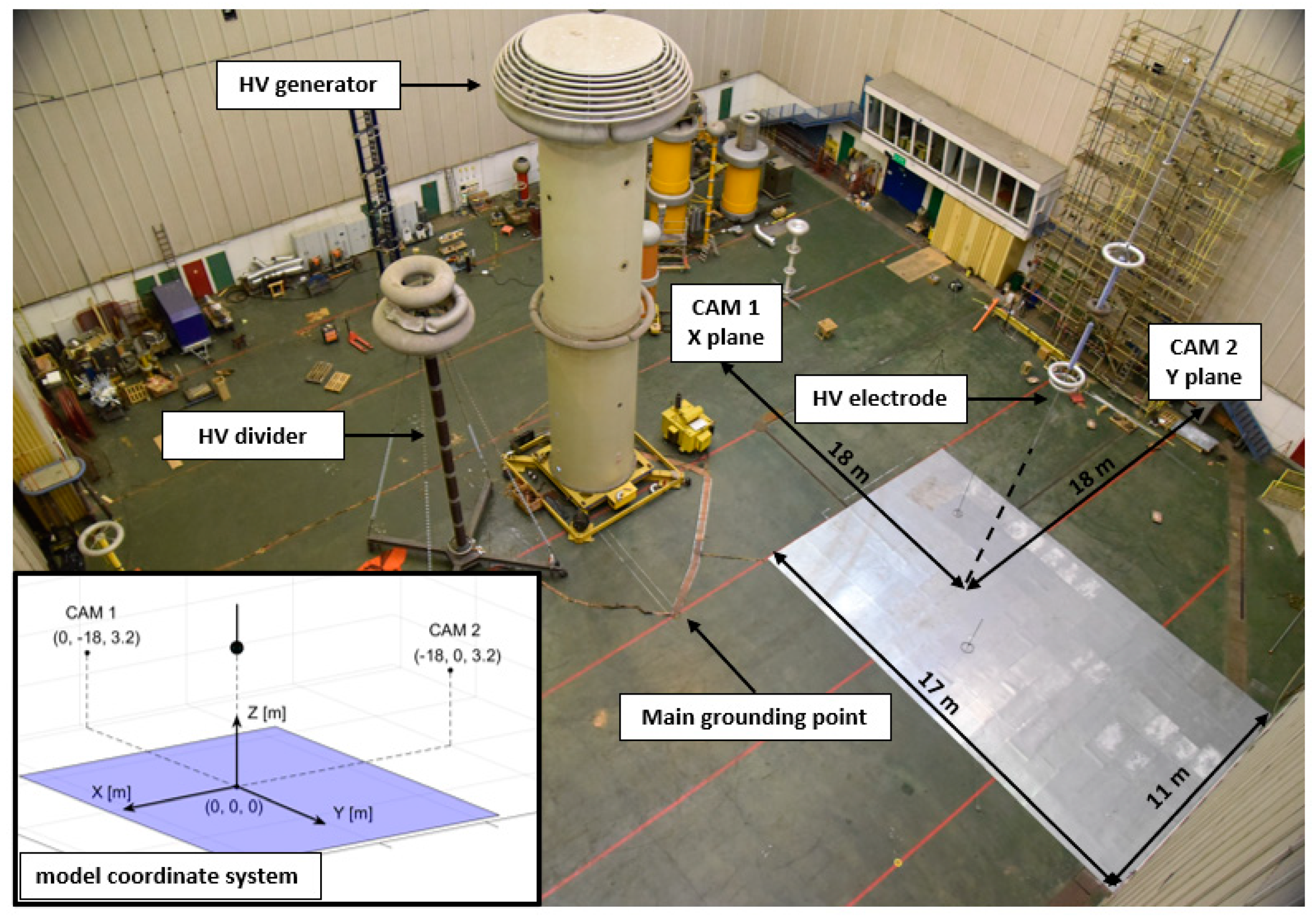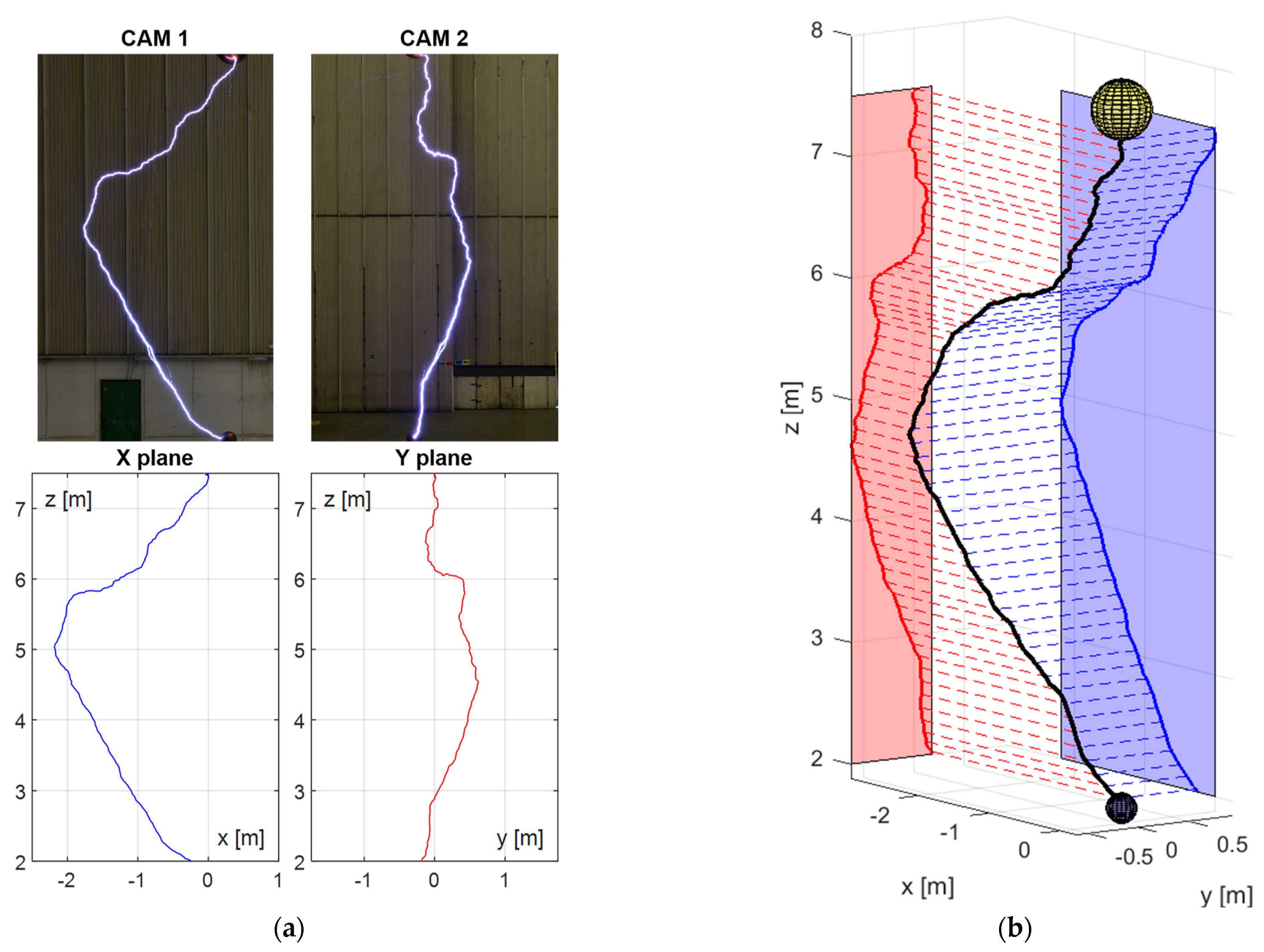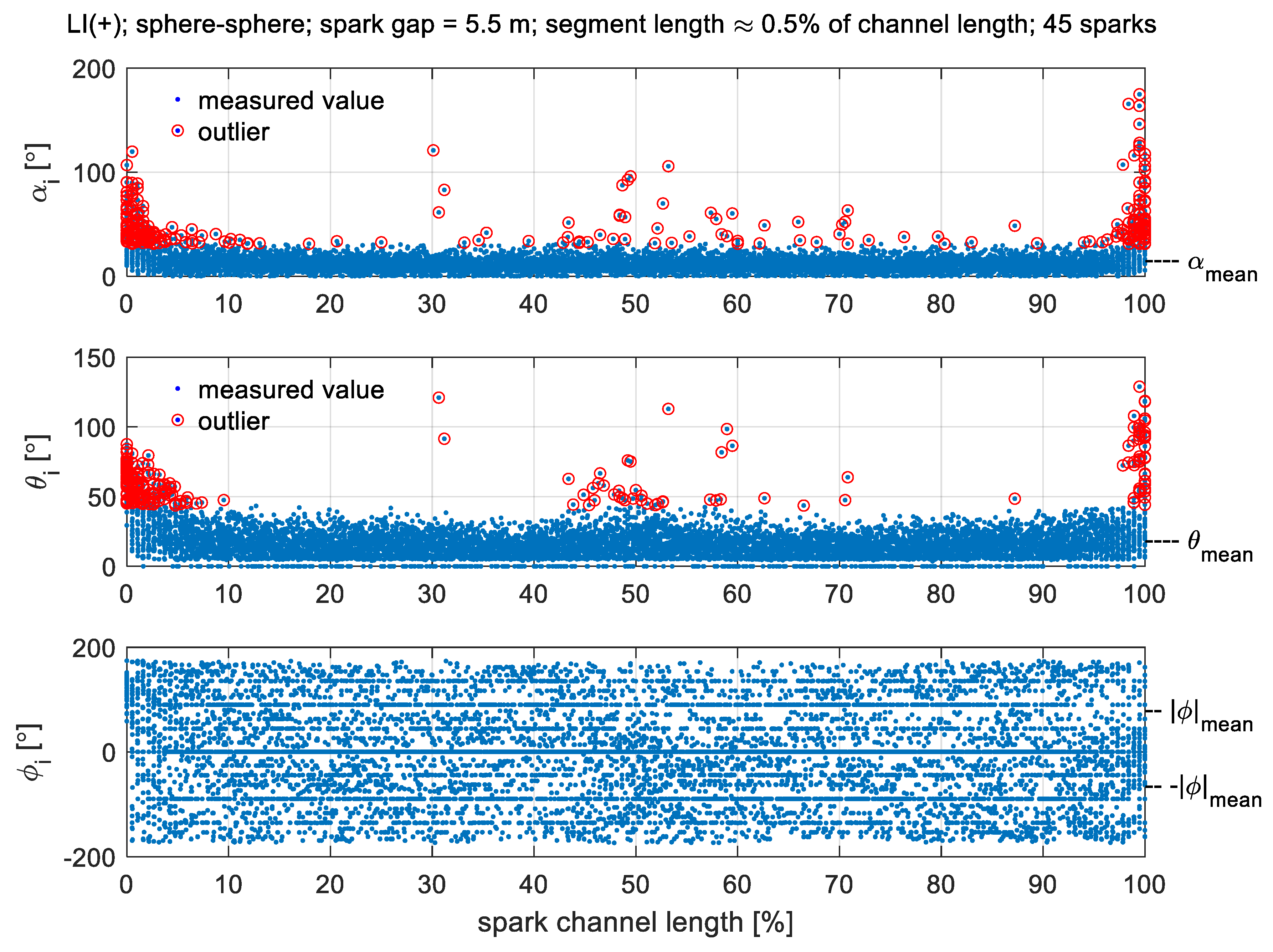Experimental Evaluation of 3D Tortuosity of Long Laboratory Spark Trajectory for Sphere-Sphere and Sphere-Plane Discharges under Lightning and Switching Impulse Voltages
Abstract
:1. Introduction
1.1. Background and Motivation
1.2. Prior-Art Research on Evaluation of Long Spark Trajectory
1.3. Paper Aim and Structure
2. Tortuosity Angles of Long Spark
3. Measurement Test Set-Up
3.1. Voltage Generator and Recording System
3.2. Electrode System
4. Measurement Procedure
4.1. High Resolution Recordings of Leader Path
4.2. Test Voltage
4.3. Measurement Uncertainty
5. Measurement Results
5.1. Atmospheric Conditions
5.2. 50% Flashover Volatge
5.3. Tortuosity
6. Summary and Conclusions
Author Contributions
Funding
Conflicts of Interest
References
- Evaluation of Lightning Shielding Analysis Methods for EHV and UHV DC and AC Transmission-Lines; CIGRE Technical Brochure TB 704; CIGRE: Paris, France, 2017.
- IEC Std. 60071-1:2019: Insulation Co-ordination—Part 1: Definitions, Principles and Rules, ed. 9.0; IEC: Geneva, Switzerland, 2019.
- He, J.L.; Wang, X.; Yu, Z.; Zeng, R. Statistical Analysis on Lightning Performance of Transmission Lines in Several Regions of China. IEEE Trans. Power Deliv. 2014, 30, 1543–1551. [Google Scholar] [CrossRef]
- Eriksson, A.J. An improved electrogeometric model for transmission line shielding analysis. IEEE Trans. Power Deliv. 1987, 2, 871–886. [Google Scholar] [CrossRef]
- Rizk, F.A.M. Modeling of transmission line exposure to direct lightning strikes. IEEE Trans. PWRD 1990, 5, 1983–1997. [Google Scholar]
- Dellera, L.; Garbagnati, L. Lightning stroke simulation by means of the leader progression model part II: Exposure and shieding failure evaluation of overhead lines with assessment of application graphs. IEEE Trans. Power Deliv. 1990, 5, 1983–1990. [Google Scholar]
- Dong, L.; He, J.; Zeng, R. A statistical view for fractal simulation of lightning. In Proceedings of the Asia-Pacific International Symposium on Electromagnetic Compatibility, Beijing, China, 12–16 April 2010; pp. 1227–1230. [Google Scholar]
- Les Renardierès Group. Research on Long Air Gap Discharges at Les Renardières: 1973 results. Electra 1974, 35, 49–156. [Google Scholar]
- Les Renardières Group. Positive discharges in long air gaps at Les Renardieres: 1975 results and conclusions. Electra 1977, 53, 31–153. [Google Scholar]
- Les Renardières Group. Double impulse tests of long airgaps. Part 1: Engineering problems and physical processes: The basis of recent tests. IEE Proc. Phys. Sci. Meas. Instrum. Manag. Educ. Rev. 1986, 133, 395–409. [Google Scholar]
- Amarasinghe, D.; Sonnadara, U.; Berg, M.; Cooray, V. Channel tortuosity of long laboratory sparks. Electrostatics 2007, 65, 521–526. [Google Scholar] [CrossRef]
- Diaz, O.; Hettiarachchi, P.; Rahman, M.; Cooray, V.; Vayanganie, S.P.A. Experimental study of leader tortuosity and velocity in long rod-plane air discharges. IEEE Trans. Dielectr. Electr. Insul. 2016, 23, 806–812. [Google Scholar] [CrossRef]
- Gu, S.; Xiang, N.; Chen, J.; Chen, W.; Xie, S.; He, J. 3D Channel tortuosity of long air gap discharge. In Proceedings of the 7th Asia-Pacific International Conference on Lightning (APL), Chengdu, China, 1–4 November 2011; pp. 784–787. [Google Scholar]
- Amarasinghe, D.; Sonnadara, U.; Berg, M.; Cooray, V. Fractal dimension of long electrical discharges. J. Electrost. 2015, 73, 33–37. [Google Scholar] [CrossRef]
- Perera, C.; Fernando, M.; Liyanage, P.; Cooray, V.; Rahman, M. Analysis of Channel Tortuosity using 8 m Long Laboratory Sparks. In Proceedings of the 2018 34th International Conference on Lightning Protection (ICLP), Rzeszow, Poland, 2–7 September 2018; pp. 1–6. [Google Scholar] [CrossRef]
- IEC Std. 60060-1:2010. High-Voltage Test Techniques—Part 1: General Definitions and Test Requirements, ed. 3.0; IEC: Geneva, Switzerland, 2010.
- IEC Std. 60383-2:1993. Insulators for Overhead Lines with a Nominal Voltage above 1000 V—Part 2: Insulator Strings and Insulator Sets for A.C. Systems—Definitions, Test Methods and Acceptance Criteria, ed. 1.0; IEC: Geneva, Switzerland, 1993.
- Joint Committee for Guides in Metrology (JCGM). JCGM 100:2008 Evaluation of Measurement Data—Guide to the Expression of Uncertainty in Measurement; IEC: Geneva Switzerland, 2008. [Google Scholar]
- IEC Std. 60060-2:2010. High-Voltage Test Techniques—Part 2: Measuring Systems; IEC: Geneva, Switzerland, 2010.
- ISO 13528:2015. Statistical Methods for Use in Proficiency Testing by Interlaboratory Comparison; ISO: Geneva, Switzerland, 2015.








| Impulse 1 | Electrodes 2 | d [m] | t [°C] | R [%] | p [hPa] | Kt [–] |
|---|---|---|---|---|---|---|
| SI (+) | S—P | 3.3 | 8.4 | 84 | 999 | 0.993 |
| SI (−) | S—P | 3.3 | 7.2 | 78 | 1000 | 1.001 |
| LI (+) | S—P | 3.3 | 7.2 | 86 | 999 | 0.985 |
| LI (−) | S—P | 3.3 | 7.2 | 86 | 999 | 1.022 |
| SI (+) | S—S | 3.3 | 9.1 | 81 | 999 | 0.989 |
| SI (−) | S—S | 3.3 | 7.2 | 78 | 1000 | 1.006 |
| LI (+) | S—S | 3.3 | 7.2 | 70 | 1013 | 0.993 |
| LI (−) | S—S | 3.3 | 7.2 | 70 | 1013 | 1.026 |
| SI (+) | S—P | 5.5 | 7.6 | 78 | 1002 | 0.996 |
| LI (+) | S—P | 5.5 | 6.8 | 83 | 1003 | 0.986 |
| SI (+) | S—S | 5.5 | 7.8 | 75 | 1002 | 0.992 |
| LI (+) | S—S | 5.5 | 8.0 | 88 | 999 | 0.988 |
| Impulse 1 | Electrodes 2 | d [m] | U50 [kV] | s [kV] | Umean [kV] | σU [kV] | TCmean [μs] | σTc [μs] |
|---|---|---|---|---|---|---|---|---|
| SI (+) | S—P | 3.3 | 1140 | 45 | 1200 | 12.1 | 178.1 | 15.2 |
| SI (−) | S—P | 3.3 | 2277 | 99 | 2161 | 147.3 | 108.9 | 25.7 |
| LI (+) | S—P | 3.3 | 1870 | 20 | 2002 | 13.8 | 12.0 | 1.8 |
| LI (−) | S—P | 3.3 | 2699 | 41 | 2857 | 18.4 | 6.4 | 0.7 |
| SI (+) | S—S | 3.3 | 1362 | 66 | 1423 | 25.3 | 166.6 | 22.8 |
| SI (−) | S—S | 3.3 | 2359 | 120 | 2295 | 146.4 | 124.7 | 39.2 |
| LI (+) | S—S | 3.3 | 2063 | 16 | 2101 | 13.7 | 13.3 | 3.2 |
| LI (−) | S—S | 3.3 | 2507 | 53 | 2547 | 16.9 | 9.5 | 1.2 |
| SI (+) | S—P | 5.5 | 1446 | 52 | 1598 | 7.4 | 222.4 | 11.1 |
| LI (+) | S—P | 5.5 | 3032 | 40 | 3181 | 8.5 | 19.3 | 6.0 |
| SI (+) | S—S | 5.5 | 1775 | 79 | 1935 | 16.5 | 226.1 | 27.9 |
| LI (+) | S—S | 5.5 | 3167 | 28 | 3364 | 17.8 | 14.5 | 3.6 |
| Impulse 1 | Electrodes 2 | d [m] | αmean [°] | σα [°] | θmean [°] | σθ [°] | |φ|mean [°] | σ|φ| [°] |
|---|---|---|---|---|---|---|---|---|
| SI (+) | S—P | 3.3 | 17.4 | 9.9 | 22.6 | 14.1 | 76.9 | 61.1 |
| SI (−) | S—P | 3.3 | 14.4 | 8.3 | 25.2 | 15.8 | 79.3 | 59.9 |
| LI (+) | S—P | 3.3 | 14.2 | 8.1 | 16.9 | 10.4 | 71.1 | 60.5 |
| LI (−) | S—P | 3.3 | 12.0 | 6.9 | 15.4 | 8.8 | 71.4 | 61.3 |
| SI (+) | S—S | 3.3 | 15.4 | 8.9 | 25.9 | 15.3 | 74.4 | 60.6 |
| SI (−) | S—S | 3.3 | 13.3 | 7.6 | 22.3 | 13.5 | 73.8 | 59.9 |
| LI (+) | S—S | 3.3 | 13.0 | 7.4 | 16.7 | 9.4 | 68.7 | 61.0 |
| LI (−) | S—S | 3.3 | 12.4 | 7.3 | 14.8 | 8.6 | 64.8 | 58.6 |
| SI (+) | S—P | 5.5 | 16.7 | 9.5 | 22.5 | 14.5 | 77.8 | 60.9 |
| LI (+) | S—P | 5.5 | 12.6 | 7.3 | 15.9 | 9.3 | 77.5 | 61.2 |
| SI (+) | S—S | 5.5 | 15.1 | 8.7 | 29.3 | 17.4 | 83.6 | 60.6 |
| LI (+) | S—S | 5.5 | 11.5 | 6.5 | 15.8 | 9.1 | 71.8 | 60.6 |
| Impulse | Parameter | Present Paper | Ref. [11] | Ref. [12] | Ref. [13] | |
|---|---|---|---|---|---|---|
| d | 3.3 m | 5.5 m | 0.5 m | 7–8 m | 3 m | |
| Electrodes | S-P 1 | S-P 1 | B-P 2 | B-P 2 | B-P 2 | |
| SI (+) | α | 17.4° ± 9.9° | 16.7° ± 9.5° | 11.8° ± 1.4° | 6.3° ± 5.8° | 13.3° ± 9.9° |
| θ | 22.6° ± 14.1° | 22.5° ± 14.5° | - | 20.9° ± 20.9° | 23.9° ± 19° | |
| φ | 76.9° ± 61.1° | 77.8° ± 60.9° | - | - | - | |
| SI(−), LI(+), LI(−) | α, θ, φ | see Table 3 | see Table 3 | - | - | - |
Publisher’s Note: MDPI stays neutral with regard to jurisdictional claims in published maps and institutional affiliations. |
© 2021 by the authors. Licensee MDPI, Basel, Switzerland. This article is an open access article distributed under the terms and conditions of the Creative Commons Attribution (CC BY) license (https://creativecommons.org/licenses/by/4.0/).
Share and Cite
Molas, M.; Szewczyk, M. Experimental Evaluation of 3D Tortuosity of Long Laboratory Spark Trajectory for Sphere-Sphere and Sphere-Plane Discharges under Lightning and Switching Impulse Voltages. Energies 2021, 14, 7409. https://doi.org/10.3390/en14217409
Molas M, Szewczyk M. Experimental Evaluation of 3D Tortuosity of Long Laboratory Spark Trajectory for Sphere-Sphere and Sphere-Plane Discharges under Lightning and Switching Impulse Voltages. Energies. 2021; 14(21):7409. https://doi.org/10.3390/en14217409
Chicago/Turabian StyleMolas, Michał, and Marcin Szewczyk. 2021. "Experimental Evaluation of 3D Tortuosity of Long Laboratory Spark Trajectory for Sphere-Sphere and Sphere-Plane Discharges under Lightning and Switching Impulse Voltages" Energies 14, no. 21: 7409. https://doi.org/10.3390/en14217409
APA StyleMolas, M., & Szewczyk, M. (2021). Experimental Evaluation of 3D Tortuosity of Long Laboratory Spark Trajectory for Sphere-Sphere and Sphere-Plane Discharges under Lightning and Switching Impulse Voltages. Energies, 14(21), 7409. https://doi.org/10.3390/en14217409






